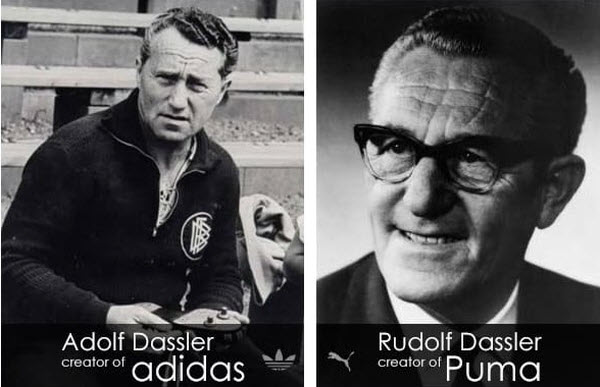In every major sports event, participants are often seen wearing one of two prominent brands: Adidas and Puma. These two companies are globally recognized as the leading manufacturers of sports apparel and equipment and are official sponsors of numerous international tournaments, as well as many national teams and clubs. Despite their current success, the origins of Adidas and Puma have a story worthy of a novel or film. The tale begins with a successful family business between two brothers, which soon turned into a fierce competition that spanned the 20th century, including the Nazi era, and even caused significant division in their hometown. This article delves into the creation of Adidas and Puma and the nature of their ongoing rivalry.

It all started in the small town of Herzogenaurach, Germany, in the 1920s, where two brothers owned a small company called “Gebrüder Dassler Schuhfabrik” (Dassler Brothers Shoe Factory). Founded in 1919, they initially worked together from their parents’ home, crafting shoes. The older brother, Rudolf, known as “Rudi,” was outgoing and enjoyed sales, while the younger brother, Adolf, or “Adi,” was more reserved, focusing on designing and producing sports shoes. By 1927, the company had grown to 12 employees, necessitating a move to larger premises.

Like many of their compatriots, Rudolf and Adolf joined the Nazi Party after Hitler came to power in 1933. Their shoe business remained modest until 1936 when the Berlin Olympics provided a significant boost. The brothers managed to get American sprinter Jesse Owens, a four-time gold medalist, to wear their running shoes, which greatly increased their market presence.

Despite their successful partnership, tensions between the brothers grew. The exact cause remains unknown, even to their descendants, though several theories suggest the discord might have been due to company success, personal differences between their wives, or disputes during World War II. One story suggests that during an air raid, Rudolf and his wife were already in a shelter when Adi and his wife arrived, leading to a misunderstanding that escalated into a fight. Later, Rudolf was reportedly conscripted into the German army in 1943, allegedly due to arrangements made by Adi and his wife, though records indicate Rudolf volunteered. He was captured by the Nazis for leaving his post and later by Allied forces, supposedly after being reported by his brother. Meanwhile, Adi began selling shoes to American soldiers. Even after the war and the fall of Nazism, the brothers continued to accuse each other of being more Nazi than the other.
In 1948, the brothers’ strained relationship culminated in the division of their company. Adi named his new company “Adidas,” a blend of his first and last names, while Rudolf named his company “Puma.” Both companies established competing factories on opposite sides of Herzogenaurach. The rivalry profoundly affected the town’s economy, as most residents worked for either Adidas or Puma. This led to a strict division within the town, with people even avoiding relationships with those loyal to the rival company. Local businesses, from shops to bakeries, catered exclusively to either Adidas or Puma customers. It was said that people in Herzogenaurach would first check the brand of your shoes before deciding whether to speak with you. Even after the founders’ deaths in the 1970s, they were buried on opposite sides of the same cemetery, symbolizing that the rivalry persisted even in death.

Despite the intense competition, both companies thrived simultaneously. Puma, led by Rudolf, boasted a superior sales team, while Adidas, led by Adi, excelled in technical components and athlete relationships. This led to Adidas generally having a financial edge over Puma, with Adidas’s market capitalization reaching approximately $51 billion and employing 5,700 people from 100 countries, while Puma’s market cap is $7 billion with 1,300 employees. Despite their global fame and competition, a new player emerged in the sports shoe industry: Nike, which has since become the world’s second-largest sportswear brand after Adidas.

Today, Herzogenaurach remains a unique town where nearly every resident wears either Puma or Adidas gear. Employees of both companies often mock each other about their respective brands when they meet in the streets. The town’s mayor is compelled to wear both brands’ attire for political neutrality, despite his family’s loyalty to one of the brands. In 2009, he even had to wear one shoe from each company during a friendly football match aimed at restoring peace after decades of trade rivalry.
